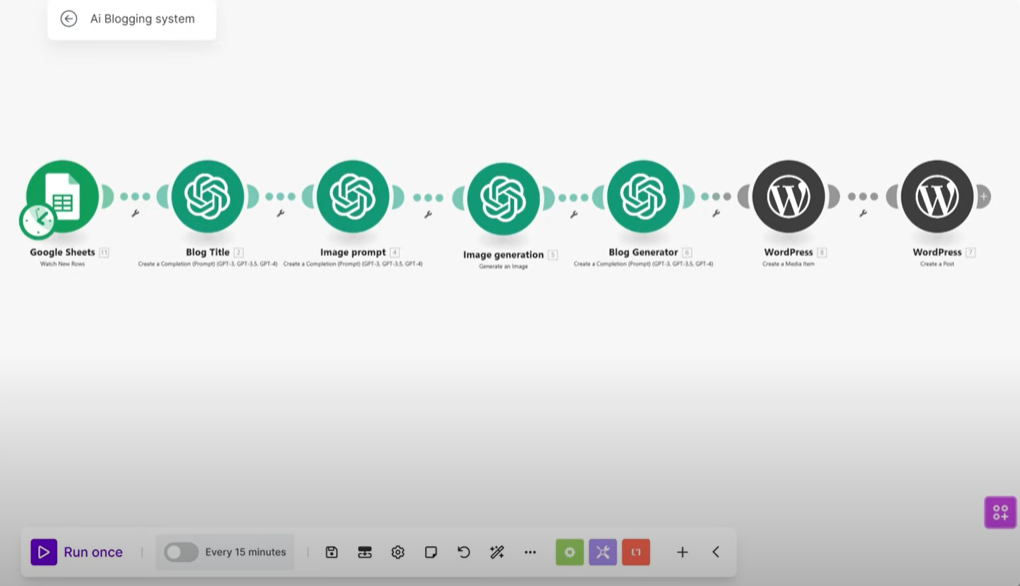Auto blogging can boost your content creation efforts. But how do you do it right?
In today’s digital age, auto blogging has emerged as a popular strategy for many. It allows content creators to automate the process of generating and publishing posts. This can save time and resources. Yet, it’s essential to follow best practices to ensure quality and relevance.
Proper execution can lead to increased traffic and engagement. By using the right tools and techniques, you can streamline your blogging process. This guide will dive into the key strategies for successful auto blogging. Stay tuned to learn how to make the most of this powerful tool.
Table of Contents
ToggleIntroduction To Auto Blogging
Auto blogging helps automate content creation for websites. Follow best practices like using quality sources and avoiding duplicate content. Keep your blog updated and relevant.
### Introduction to Auto Blogging Auto blogging can be a game-changer for anyone looking to simplify their content creation process. Imagine having a blog that updates itself with fresh, relevant content without you lifting a finger. It sounds like a dream, right? But, how can you make it work for you? Let’s dive into the essentials of auto blogging. ### What is Auto Blogging? Auto blogging is the practice of automating the process of generating and publishing content on your blog. This can be done using specialized tools and plugins that pull content from various sources. These sources can include RSS feeds, social media platforms, or even other blogs. You set the parameters, and the software does the rest. It’s like having a virtual assistant dedicated to keeping your blog updated. ### Importance of Auto Blogging Why should you care about auto blogging? First, it saves you a ton of time. Instead of spending hours researching and writing, you can focus on other important tasks. This is particularly useful if you manage multiple blogs or have a busy schedule. Second, it ensures a consistent flow of content. Regular updates can improve your blog’s search engine ranking. It keeps your audience engaged and coming back for more. Think about it: How much more productive could you be if you had this automation in place? Auto blogging isn’t just a time-saver; it’s a strategic advantage. By leveraging technology, you can stay ahead of the competition and keep your readers satisfied. Are you ready to take your blogging to the next level?
Choosing The Right Tools

Credit: www.xinsurance.com
Choosing the right tools can make or break your auto blogging journey. The right tools streamline your process and enhance content quality. They also save time and ensure consistency. Let’s dive into the best practices for selecting these tools.
Top Auto Blogging Platforms
Several platforms are available for auto blogging. WordPress is popular due to its flexibility. It offers numerous plugins and themes. Another option is Blogger, which is easy to use. It suits beginners and integrates well with Google services. Medium is also great for content distribution. It has a large audience base. Each platform has its pros and cons. Choose one that fits your needs and skills.
Essential Plugins And Software
Plugins and software are crucial for auto blogging. Yoast SEO is a must-have for optimizing content. It helps with keyword placement and readability. Another essential plugin is WP Robot. It automates content creation from various sources. ContentStudio is also valuable. It curates and schedules posts across social media platforms. Grammarly checks for grammar and spelling errors. These tools ensure your blog is polished and professional.
Content Strategy
Creating an effective content strategy is crucial for auto blogging success. You need a solid plan to ensure your blog generates traffic and keeps readers engaged. Let’s dive into some best practices that can help you achieve this.
Identifying Your Niche
Finding your niche is the first step. Think about what topics you are passionate about and knowledgeable in. This will help you produce authentic and engaging content.
Consider the interests of your target audience. What are they searching for? Use tools like Google Trends to see what’s popular. This ensures your blog aligns with current interests.
Look at your competitors. What niche are they targeting? Identify gaps in their content that you can fill. This helps you stand out and attract more readers.
Content Curation Techniques
Curating content is an art. You need to find valuable information and present it in a way that adds value to your readers. Use trusted sources and verify the facts before sharing.
Organize your content logically. Group similar topics together and create a clear structure. This makes it easier for readers to navigate and find what they need.
Use a mix of content types. Include articles, videos, infographics, and podcasts. This keeps your blog interesting and appeals to different preferences.
How do you plan to make your content strategy stand out? Share your thoughts in the comments below!
Seo Optimization
Optimizing your auto blog for search engines is crucial. It helps your content rank better and reach a wider audience.
Keyword Research Tips
Keyword research is the first step in SEO. Start with identifying relevant keywords. Use tools like Google Keyword Planner. Look for keywords with low competition. Aim for higher search volume. Long-tail keywords are beneficial. They target specific queries. Make a list of potential keywords. Analyze their performance regularly.
On-page Seo Best Practices
On-page SEO involves optimizing individual pages. Start with your title tags. Use your primary keyword in the title. Keep it under 60 characters. Meta descriptions are important. They should be engaging and include keywords. Aim for 150-160 characters. Use header tags appropriately. H1 for titles, H2 and H3 for subheadings. Include keywords in headers.
Content should be original and valuable. Avoid duplicate content. Use keywords naturally. Overuse can lead to penalties. Optimize images with alt text. Include relevant keywords. Internal linking improves navigation. Link to related posts within your blog. Ensure your site is mobile-friendly. Responsive design enhances user experience. Page speed is crucial. Faster pages rank better.
Legal Considerations
When diving into auto blogging, it’s crucial to understand the legal landscape. Legal considerations help avoid pitfalls that could lead to lawsuits or penalties. Let’s explore key areas like copyright, fair use, and privacy policies to keep your blog compliant and safe.
Copyright And Fair Use
Copyright laws protect original content. Using someone else’s work without permission can lead to legal trouble. Always seek permission or use content in the public domain. Fair use allows limited use of copyrighted material for commentary, criticism, or news reporting. But, it has limits. Overstepping can still result in infringement claims. Knowing these rules helps maintain a lawful blog.
Privacy Policies
Privacy policies inform users about data collection and usage. Most countries require them by law. They build trust with your audience. Be transparent about what data you collect and how you use it. Include details on cookies, email addresses, and other personal information. A clear policy keeps you compliant and builds user confidence.
Monetization Strategies
Monetization strategies are crucial for successful auto blogging. They help you earn money from your blog while providing value to your audience. Two common and effective strategies are Affiliate Marketing and Ad Revenue. Both offer different ways to generate income, and you can use them together or separately.
Affiliate Marketing
Affiliate marketing involves promoting products or services on your blog. You earn a commission for every sale made through your referral links. First, sign up for affiliate programs related to your blog’s niche. Then, include affiliate links in your posts naturally. Write honest reviews and recommend products you trust. This builds credibility and encourages your readers to make purchases. Monitor your links and update them regularly to ensure they are working.
Ad Revenue
Ad revenue is another popular monetization strategy. You earn money by displaying ads on your blog. Sign up for ad networks like Google AdSense. They provide ads that match your content. Place ads in visible areas, but avoid overwhelming your readers. Balance is key. Too many ads can drive visitors away. Track your ad performance and adjust your placements as needed. Experiment with different ad formats and positions to find the most effective combination.
Maintaining Content Quality
Maintaining content quality is crucial for successful auto blogging. Good content attracts readers and builds trust. It also improves SEO performance. Below are best practices to ensure high-quality content.
Avoiding Duplicate Content
Duplicate content can harm your blog’s SEO. Search engines prefer unique content. Make sure to create original posts. Use plagiarism checkers to verify content uniqueness. Avoiding duplicates helps maintain your blog’s credibility.
Ensuring Relevance And Value
Your content should be relevant to your audience. It should provide value and answer their questions. Research popular topics in your niche. Use keywords that your audience searches for. This will help attract more readers. Always aim to inform or entertain your audience.
Analytics And Performance Tracking
In the world of auto blogging, analytics and performance tracking play a crucial role. They help you understand how your content performs. You can make data-driven decisions with these insights. Monitor key metrics and use the right tools to optimize your blog’s performance. This ensures consistent growth and engagement.
Key Metrics To Monitor
Several metrics can help you gauge your blog’s success. First, track the number of page views. This shows how many times your content is viewed. Second, monitor the bounce rate. It reveals if visitors leave your site quickly. A high bounce rate may indicate that your content needs improvement.
Third, check the average session duration. This tells you how long visitors stay on your site. Longer sessions often mean engaging content. Fourth, look at the traffic sources. Know where your audience comes from, whether it is organic, direct, or referral. Understanding this helps you focus your marketing efforts.
Tools For Analytics
Using the right tools can make tracking your blog’s performance easier. Google Analytics is a popular choice. It provides detailed insights into your site’s traffic. You can see page views, bounce rates, and session durations. Another useful tool is Google Search Console. It helps you monitor your site’s presence in Google search results.
SEMrush is another valuable tool. It offers a comprehensive analysis of your website’s performance. Use it to track keywords and analyze competitors. Ahrefs is also helpful for backlink analysis. It shows who links to your site and the quality of those links. These tools help you optimize your auto blog effectively.
Future Of Auto Blogging
The future of auto blogging looks very promising. With advancements in technology, the way we produce and consume content is changing. Auto blogging will continue to evolve, bringing new opportunities and challenges. Understanding these changes is key to staying relevant and effective.
Emerging Trends
Technology in auto blogging is advancing rapidly. Machine learning and AI are becoming more sophisticated. These technologies help generate high-quality content. They also personalize content for different audiences. This makes blogs more engaging.
Voice search is another trend to watch. More people are using voice assistants. Blogs need to optimize for voice search. This means using natural language and answering common questions. It can help your blog reach more people.
Adapting To Changes
Auto blogging tools are always improving. Bloggers need to stay updated. Using the latest tools can give you an edge. It makes creating and managing content easier.
Understanding your audience is crucial. Preferences can change over time. Regularly review your audience data. Adapt your content strategy to meet their needs. This keeps your blog relevant.
SEO practices are also evolving. Search engines are getting smarter. They value high-quality, relevant content more than ever. Focus on creating valuable content for your readers. This will improve your search rankings.

Credit: www.databricks.com
Frequently Asked Questions
Do And Don’ts Of Blogging?
Do: Write engaging content, use keywords, be consistent, interact with readers, and proofread. Don’t: Plagiarize, ignore SEO, neglect visuals, write lengthy paragraphs, or forget to update old posts.
Is Autoblogging Legal?
Autoblogging is legal if you use properly sourced content and respect copyright laws. Always give credit to original authors.
How To Make An Automated Blog?
Use WordPress with automation plugins like WP Robot. Integrate AI tools for content creation. Schedule regular posts. Optimize for SEO. Monitor performance.
Does Autoblogging Work?
Yes, autoblogging can work. It automatically generates content, saving time. Quality and relevance depend on the setup and sources used.
Conclusion
Auto blogging can be a powerful tool. Use best practices for success. Focus on quality content. Keep posts relevant and engaging. Optimize for SEO. Regular updates are key. Monitor your blog’s performance. Adjust strategies as needed. Stay consistent. Engage with your audience.
Build trust and credibility. Follow these tips to enhance your auto blogging journey. Remember, quality over quantity always wins. Happy blogging!




